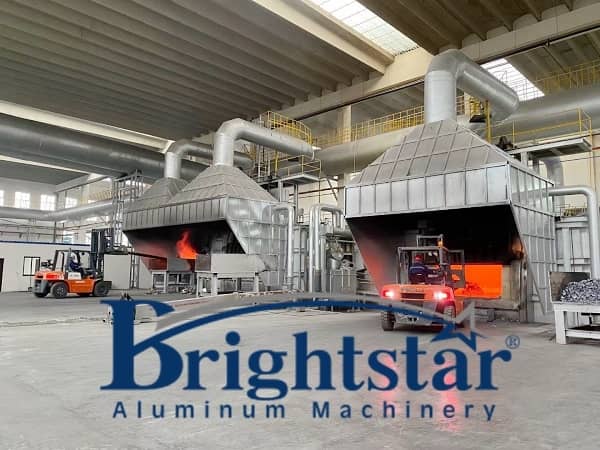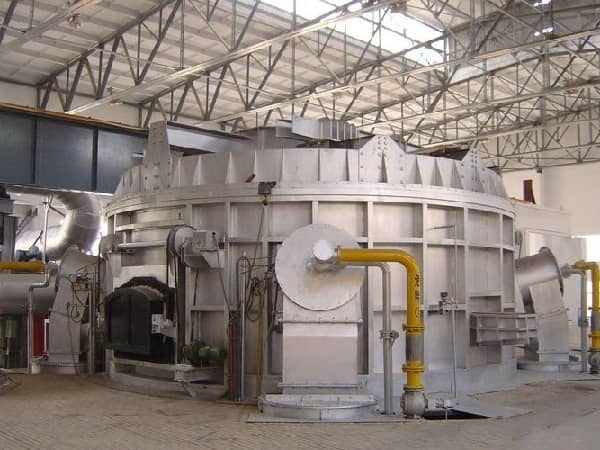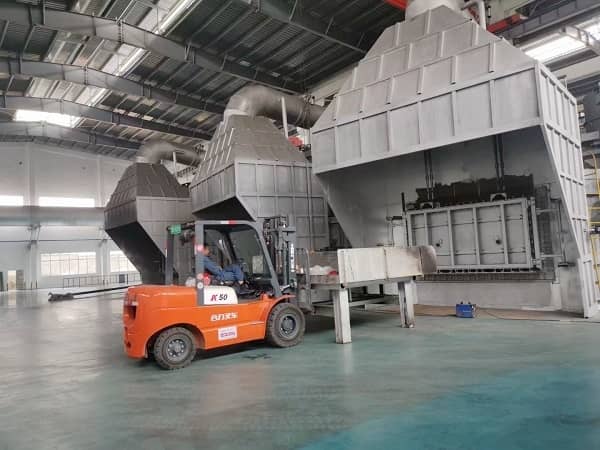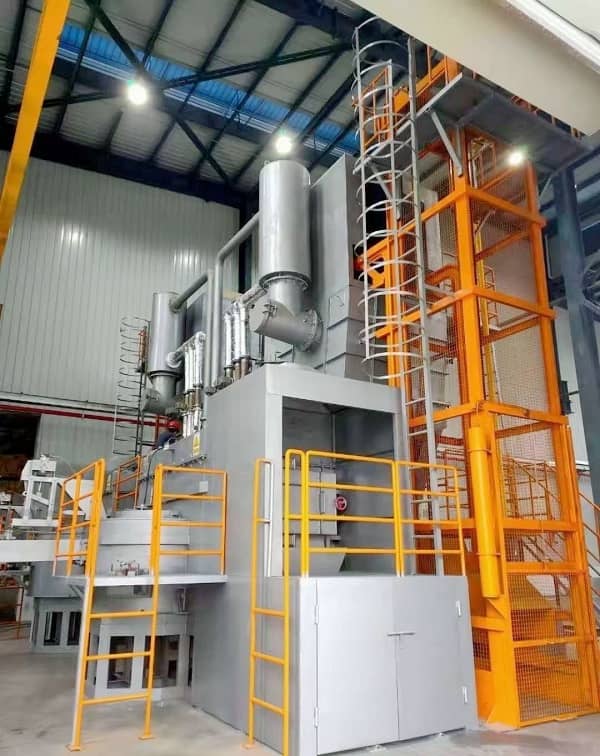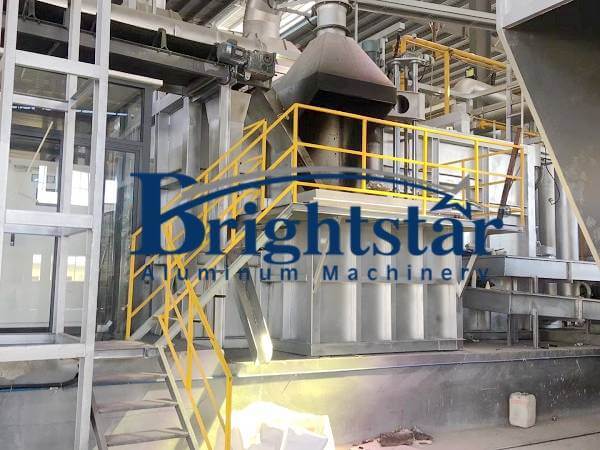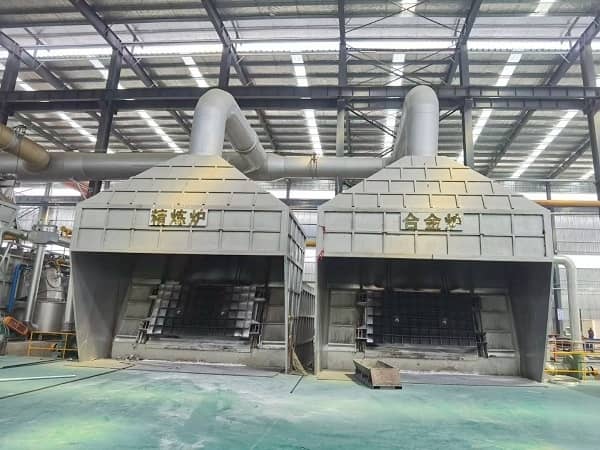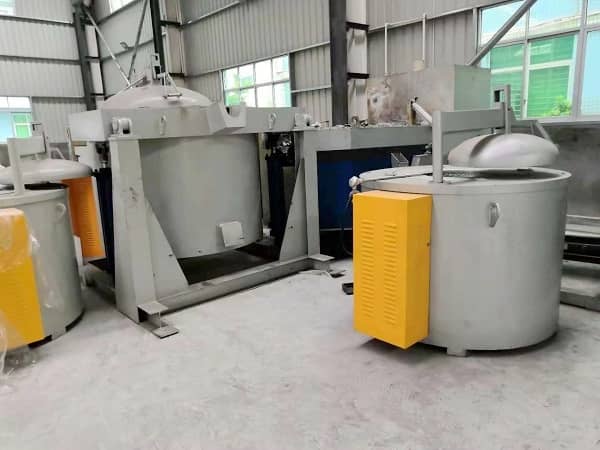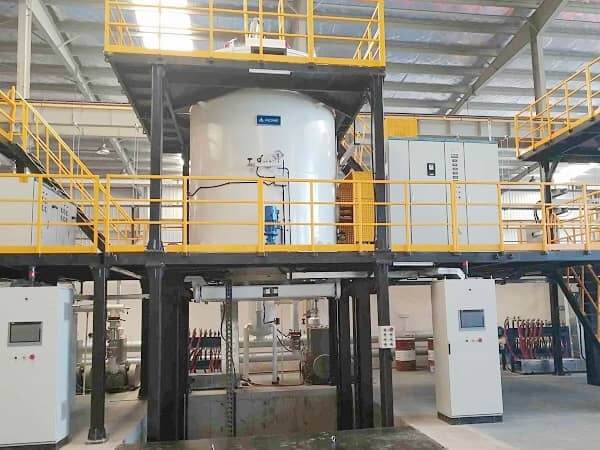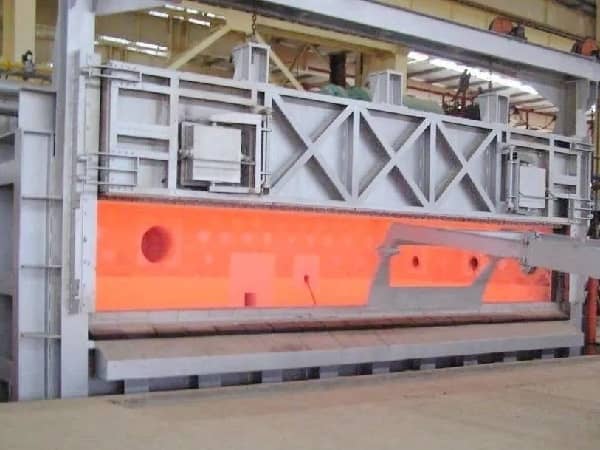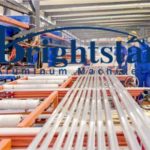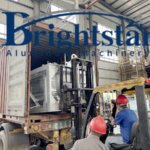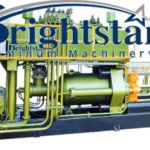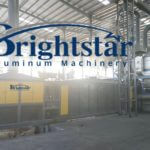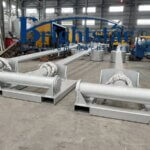All information you need to know about aluminum melting furnace
All information you need to know about aluminum melting furnace
Role and types of aluminum melting furnaces, precautions for use, common troubleshooting and regular maintenance
The aluminum melting furnace is a new type of high-efficiency and energy-saving furnace developed based on the aluminum smelting process.
It can meet the requirements of the aluminum smelting process: strict alloy composition requirements, discontinuous production, large single furnace capacity, etc.
It can achieve the goal of reducing consumption, reducing burning loss, improving product quality, reducing labor intensity, improving working conditions and increasing production efficiency.
It is suitable for intermittent operations, smelting with alloying and recycled materials.
The role of secondary aluminum melting equipment
Recycled aluminum melting equipment includes melting furnaces, holding furnaces, fans, combustion systems, etc.
There are many types of melting furnaces, and their functions are all the same.
The first is to melt the charging materials and additives.
The charging materials include scrap aluminum, master alloy, industrial silicon and pure aluminum ingots;
The second is to cause a series of chemical and physical reactions to occur between the melts at a certain temperature in the furnace, so that the impurities in them form dross or gas and are removed;
The third is to adjust the composition so that the content of various elements in the alloy meets relevant standards;
The fourth is to carry out modification and other treatments on the alloy melt to refine the fine particles so that the alloy can meet the relevant physical properties.
Therefore, the form and structure of the melting furnace play an important role in the production capacity, cost, product quality and environmental protection of recycled aluminum production.
Common types of aluminum melting furnaces
Most common aluminum melting furnaces have two structural forms: rectangular or round.
Reasonable aluminum melting furnace structural design can significantly improve the heat transfer effect of the furnace, increase melting capacity, and reduce energy consumption.
Round aluminum melting furnace
Under the premise of the same capacity, the internal volume of a round aluminum melting furnace is larger than that of a rectangular furnace, and the volumetric thermal intensity of the furnace is greater than that of a rectangular furnace, which can achieve a greater melting rate.
At the same time, the round structure also facilitates the installation of the burner, helps organize reasonable airflow in the furnace, improves heat exchange efficiency, and reduces energy consumption for melting aluminum.
In addition, the method of opening the top of the round aluminum melting furnace for charging is conducive to rapid furnace charging in a short period of time, shortening the charging time, and improving the charging operation rate.
At the same time, due to the effect of self-weight, the sealing between the furnace cover and the furnace body is relatively easy to solve.
Therefore, most of the large-scale aluminum melting furnaces newly built in China in recent years adopt a round structure.
Round aluminum melting furnace
Rectangular aluminum melting furnace
When using a round furnace-shaped structure for production, due to the need for cover opening and skimming operations, the height of the workshop is significantly increased, and 2 to 3 furnace positions are occupied.
Therefore, the utilization rate of the round aluminum melting furnace workshop is relatively low.
The investment in factory infrastructure is also much higher than that of rectangular furnaces.
For this reason, many manufacturing companies choose rectangular aluminum melting furnaces.
The rectangular smelting furnace only requires a forklift operator to charge scrap materials into it.
It can not only smelt aluminum scraps, but also UBC, scrap aluminum wires, aluminum ingots, etc.
The large furnace door makes it easy to make skimming;
It can also be equipped with a dust collector, a casting machine, and aluminium dross processing machine for use together to improve the recovery rate and meet the government emission standard.
The chamber of the furnace is large, has a good heat preservation effect, high thermal efficiency and fast melting speed;
The furnace adopts an air-cooled furnace door heat exchange system, which is more complete and energy-saving than direct air combustion.
The aluminum material is directly heated inside the flame furnace to melt the aluminum material quickly and efficiently.
After the melted composition reaches the standard, it is discharged to the continuous ingot casting machine through the outlet to complete the casting.
Compared with a round aluminum smelting furnace in which the burners are evenly arranged around the circumference, the regenerative rectangular furnace arranges the burners on two opposite furnace walls and periodically turns on the burners arranged diagonally.
The furnace temperature distribution obtained by the structure is more uniform, and the relative standard deviation of the furnace temperature in the later stage of smelting is stable at about 9%.
The heat loss of the furnace is very small, the melting speed is fast, and the operation is easy.
Moreover, the rectangular furnace adopts PID zero-crossing trigger thyristor, which has high precision and smart meter temperature control.
The furnace has excellent stability and dual over-temperature alarm control to ensure that the workpiece does not over-temperature.
Each mechanical transmission part of the electric furnace adopts interlock control, that is, the power supply to the ventilator device and heating element is automatically cut off after the furnace door is opened.
Only after the furnace door is closed in place can the power supply of the ventilator device and heating element be turned on to prevent malfunctions and accidents caused by misoperation, thereby increasing work safety.
Rectangular aluminum melting furnace
Vertical aluminum melting furnace
The vertical aluminum melting furnace is a new type of high-efficiency and energy-saving aluminum melting furnace developed based on the characteristics of continuous casting, rolling and other continuous smelting processes of aluminum.
It can well meet process requirements, improve working conditions and increase production efficiency.
Vertical structure aluminum melting furnaces are widely used in some small and medium-sized enterprises and die-casting industries.
In this furnace type, a vertical flue with a larger cross-section is installed at the rear of the furnace, and a high-speed burner is installed at the bottom of the flue.
The aluminum ingots and charging materials are added from the top of the flue, and are quickly melted by the flame impact at the bottom of the flue.
At the same time, the flue gas can fully exchange heat with the added cold charge during the discharge process, so the thermal efficiency of the vertical melting furnace is very high, usually reaching more than 50%, and the energy consumption index is relatively good.
The furnace-shaped structure of the vertical furnace is adopted, the furnace gas circulation is strong, the furnace temperature is uniform, and there is no local overheating or over-burning.
It improves product quality and extends the service life of the furnace.
At the same time, the flame is far away from the furnace material and the burning loss is low.
When charging materials from the vertical furnace, the flame and the charge flow in opposite directions.
The liquid aluminum in the molten pool heats up to the required temperature (720°C ~ 740°C) due to heat transfer by the flame.
The flame penetrates the aluminum material along the bottom of the vertical furnace to the upper part of the shaft furnace, fully carrying out the process.
Through heat exchange, the flame temperature is transferred to the furnace charging materials and then discharged from the furnace top at a temperature lower than 200°C. Therefore, the exhaust smoke loss is significantly reduced and the thermal efficiency is greatly improved.
☆Features:
Combination of vertical furnace preheating and impact heating, fast melting speed, low energy consumption, small burning loss, compact structure, long furnace life and simple operation.
☆Specifications
According to the melting rate (tons of aluminum/hour), it can be divided into eight specifications: 0.1T, 0.3T, 0.5T, 0.7T, 1T, 2T, 3T, and 5T.
☆Application
Continuous casting and rolling of aluminum rods and wires and pure aluminum strips, centralized melting of die casting, low-pressure casting and general casting.
Vertical aluminum melting furnace
Side well vortex stirring feeding aluminum melting furnace
This kind of melting furnace is also a double-chamber reverberatory furnace, which consists of a melting furnace, a charging well and a magnetic pump that form a vortex system.
During the smelting process of recycled aluminum, the scrap aluminum continuously added to the feeding well is melted by the superheated aluminum liquid, and enters the reverberatory furnace under the action of the magnetic pump.
By repeating this process, the purpose of smelting can be achieved.
It has the advantages of small metal burning loss and a high recovery rate.
The side well vortex stirring aluminum melting furnace is suitable for processing broken aluminum scrap, especially for the processing of aluminum chips and UBC material.
Aluminum chips will be conveyed and dry in the rotary kiln, and thrown into the feeding room.
The aluminum chips will be melting through a special flow channel design (side well vortex melting), a vortex will be formed in the side well, and aluminum chips will be drawn into aluminum liquid by the vortex.
The chips will melt very fast in high-temperature liquid aluminum and be molten in aluminum liquid.
More than 90% recovery rate can be got through oxygen protection dissolved state.
Liquid aluminum pump will be set in the pump room, whose function is vortex stirring in the charging opening and liquid aluminum exchange in the heating and melting.
Side well vortex stirring feeding aluminum melting furnace
Drop-type reverberatory furnace
Drop-type reverberatory furnace, also known as primary and secondary group furnace, is a more suitable reverberatory furnace group, especially effective in processing scrap aluminum materials with high-rate iron scraps.
The primary and secondary furnaces are composed of a melting furnace and a melting-refining furnace.
Both furnaces are connected to each other and there is a level difference between both furnaces.
The melting furnace only plays a melting role.
After the raw materials are charged into the melting furnace, it will be melted quickly, and then the molten aluminum flows into the melting-refining furnace.
While impurities such as iron remain in the furnace and are manually skimmed, thus reducing the contact time between iron and molten aluminum solution, reducing the melting of iron into molten aluminum.
The molten aluminum entering the melting-refining furnace is further smelted.
Since there are no impurities such as iron in the melting-refining furnace, contamination of the molten aluminum by iron is avoided during the entire melting and refining process, ensuring the quality of the molten aluminum.
The primary and secondary furnace group is a type of furnace that is very worthy of promotion.
It has low investment and strong applicability.
Currently, many companies in the local market adopt this type of furnace.
When using this group furnace, after the charging material is melted, the liquid aluminum should be released as soon as possible to reduce the residence time of the aluminum liquid in the furnace to reduce the dissolution of iron and other impurities into the aluminum liquid.
Drop-type reverberatory furnace
Rotary reverberatory furnace
Because the furnace body of the rotary furnace can rotate 360° during the production process, the thermal efficiency is greatly improved.
It also has the advantage of fast heat transfer and can basically eliminate the need for stirring operations.
In addition, the molten aluminum liquid and the refractory material are in uniform contact, which avoids uneven corrosion of the furnace wall and increases the service life of the furnace.
The disadvantage is that the fuel used must be liquid or gas.
Crucible furnace
Crucible furnace is a commonly used equipment for melting recycled aluminum alloy.
Its advantages are low investment, easy operation and a high metal recovery rate.
However, its disadvantages are small production capacity, short life and unstable composition.
It is difficult to compare with large reverberatory furnaces.
There are various forms of crucible furnaces, the most commonly used ones are cast iron crucibles and graphite crucibles.
When the crucible furnace is in use, the furnace body is fixed on the pot platform made of refractory materials, and the lower part and surrounding of the crucible furnace are combustion chambers.
When using a larger crucible furnace, due to the self-weight of the crucible furnace, the bottom of the furnace body cannot be elevated and should rest on stable refractory materials.
Especially for large cast iron crucible furnaces, the furnace body will deform at high temperatures and affect its lifetime.
The crucible furnace has strong fuel adaptability, including coal, coke, gas, etc., and has a large choice of fuel.
When using oil or gas as fuel, there is a nozzle under the crucible, which injects fuel and air for combustion and heating.
This is an oil crucible furnace or a gas furnace.
When using electric heating, a resistance heating element (resistance wire or silicon carbide rod) is arranged around the crucible, that is, a resistance crucible furnace.
Crucible furnaces that use fuel generally heat up quickly, but their temperature control cannot be very strict.
The heating rate of the resistance crucible furnace is slow, and the electric heating wire can reach 900, and the globar can reach 1200.
The temperature is lower than that of the fuel furnace.
At the same time, its equipment cost is expensive, power consumption is high, and the melting cost is high.
However, its production environment and labor conditions are better, and the melting temperature can be accurately controlled, making it suitable for the smelting of aluminum and magnesium alloys.
The external heat source first heats the crucible.
After the crucible is heated, the heat is then transferred to the metal charge or melt inside the crucible.
According to this heat transfer characteristic, the crucible furnace is an external heating melting furnace to improve thermal efficiency.
The crucibles are all made with a smaller diameter and a higher height to increase the contact area between the metal and the crucible wall.
In this way, the contact area between the molten liquid metal and the external atmosphere is relatively small, which can reduce the oxidation and outgassing of the metal, which is beneficial to the metal.
Crucible furnace
Induction furnace
This is a melting furnace that uses electromagnetic induction to heat metal.
Induction electric furnaces can be divided into line frequency furnaces (50-60 Hz), medium frequency furnaces (1-10 kilohertz) and high-frequency furnaces (200-300 kilohertz) according to different power frequencies.
There are two types of induction furnaces in terms of structure: iron core induction furnaces and iron coreless induction furnaces.
The power frequency induction furnace with an iron core is equivalent to a transformer, feeding the primary winding outside the iron core into the melting furnace.
According to the alternating current with different frequency than the power supply frequency, the induction furnace generates a large induced current in the remaining metal in the molten trench of the phase secondary winding connected to the molten pool, thereby heating the metal.
The iron-coreless induction furnace is a crucible-type melting furnace.
The primary winding, known as the inductor, is placed outside the crucible.
It is made of hollow copper tubes and is cooled by water.
After the inductor is powered, the metal in the crucible generates induced current and generates heat.
A magnetizer is arranged outside the crucible of the power frequency induction furnace to improve the electromagnetic efficiency of the furnace.
The power frequency induction furnace has very low efficiency when melting small pieces of metal materials, and it is even difficult to melt them.
It is only suitable for melting large pieces of metal materials.
Therefore, the capacity of power frequency induction furnaces is relatively large, up to several tons or more.
Since the electromagnetic effect can cause the liquid in the furnace to stir by itself, making its composition and temperature uniform, the power frequency furnace can be used to melt copper alloys, aluminum alloys and other alloys with lower melting points.
Induction furnace
Precautions for using aluminum melting furnace
1. After starting the heating furnace of the aluminum melting furnace, adjust the heating parameters and wait until the heating parameters are stable before normal heating production can be carried out.
2. Before starting up the aluminum melting furnace, you must check whether the pushing and discharging devices, circulating water, air pressure, etc. are normal,
whether the limit switch, manual and automatic switch positions are in the required positions,
Always pay attention to the cooling water, because the cooling water is the lifeline of the induction furnace, and the outlet water temperature must not exceed 60°C.
3. The aluminum melting furnace must be placed correctly during the charging process.
All large pieces of aluminum materials need to be processed before charging into the furnace.
and attention must be paid to the method, the irregular side should be placed upward as much as possible to avoid jamming the furnace lining.
4. When the aluminum melting furnace is fired for the first time when the furnace is cold, the rated power cannot be used immediately.
60%-75% of the normal power should be used for low-temperature heating.
This can avoid cracks in the refractory material of the furnace lining, and wait until the furnace lining temperature evenly reaches about 90°C.
At this time, the power can be increased to the normal process power and the formal smelting operation can be started.
5. Reasonably design the furnace structure to improve the effective use of energy.
The main factors that improve efficiency are refractory materials, insulation materials, furnace structures, control systems and burner systems.
Refractory insulation materials have good heat resistance and insulation, which will reduce energy consumption and improve its energy-saving effect.
Aluminum melting furnace production operating procedures
This regulation specifies the process and technical requirements for the operation of the melting furnace.
This regulation specifies the operating procedures for the melting furnace.
1.Before operation, operators must wear labor protection equipment, check whether the tools and equipment are in good condition, and solve problems in a timely manner if they are found.
2. Before operation, check whether the natural gas system of the furnace is normal; check whether the air supply fan and pipeline are normal.
3. Before operation, check whether the natural gas, fan, and furnace door lifting control buttons on the operation cabinet operate normally;
Check whether the nitrogen and compressed air pipelines and pressures are normal;
Check whether the natural gas burner and ignition system are normal;
Check whether the fume hood exhaust on the upper part of the furnace door is normal.
Is the fan operating normally?
4. Check whether the aluminum discharge port is normal,
and check whether the refractory materials in the molten pool and furnace wall in the furnace are peeling or falling off;
5 If there is any abnormality in the above 2-4 inspection items, report it to the workshop manager immediately and deal with it in a timely manner.
6. Before opening the empty furnace, in order to prevent deflagration, the fan must be started for purging.
Ventilation and ignition can only be carried out after the purging is completed.
7. Before adding liquid aluminum, check whether the aluminum entrance into the aluminum launder is unobstructed and whether the standing bracket is firm and safe.
Clean the slag in the launder;
When feeding aluminum, slowly rotate the aluminum ladle and tilt the control handwheel to control the flow and speed of the aluminum liquid to avoid splashing of the aluminum liquid.
8. When adding recycled materials or cold materials, the quality, status, and weight of the materials should be carefully checked;
impurities should be carefully removed, and the quantity and composition of the materials should be checked to see if they are consistent with the ingredient list.
To prevent an explosion, it is strictly prohibited to bring wet charging materials and moisture into the furnace.
9. When adding solid charge to an empty furnace, add it slowly in batches and use a small charge to pave the bottom;
Prevent large pieces of charge from hitting the bottom of the furnace and damaging the refractory material at the bottom of the furnace;
When there is liquid aluminum in the furnace, you must operate more carefully to prevent aluminum from collapsing, the liquid splashed outside the furnace and injured people.
10. When repairing or operating the furnace, it is strictly prohibited to knock or hit the furnace shell with heavy objects to prevent damage to the refractory materials in the furnace.
11. When using manual work “nitrogen + flux” refining, the nitrogen blowing tube adopts the “#” character walking pattern at the bottom of the furnace;
The nitrogen purity is ≮99.95%, the pressure is ≯0.13Mpa, the flow rate is 10-20 liters/minute, and the total gas consumption is ≯30 liters/ton;
In order to prevent the reaction between aluminum liquid and nitrogen, the refining temperature is ≯780℃;
The amount of refining agent used is 1.5~3‰ of the total mass of aluminum liquid;
When the cleanliness of the aluminum liquid is poor, the amount of refining agent can be appropriately increased, but the maximum amount should not exceed 4‰ of the total mass of the aluminum liquid.
In order to prevent heat loss during refining, the furnace door should be opened so that the entire upper part of the molten pool can be observed.
12. When skimming, wear a heat shield and turn on the furnace door fan;
Place a dross bucket at the bottom of the furnace door and remove all the dross into the dross bucket.
Do not remove the dross directly onto the furnace table.
When cleaning the furnace, it is prohibited to use the water sweeping method.
During normal production, the furnace should be cleaned every 3-6 days;
When cleaning the furnace, damage to the refractory material on the inner wall of the molten pool should be avoided.
13. The holding time of the aluminum liquid is 20 to 30 minutes, and the holding temperature is 720°C to 730°C.
14. Tools and equipment operated in front of the furnace should be kept in good condition and placed in an orderly manner. If damaged, repair it in time.
When the aluminum ladle is being lifted or transferred by the crane, people within the lifting route must avoid it.
Personnel are prohibited from operating until the hook stops.
Common faults and solutions of aluminum melting furnaces
1. Jammed material
Check whether there are foreign objects in the aluminum melting furnace.
If there are foreign objects, they need to be removed immediately.
Check if too much material is charged during ignition and the feeding shaft is stuck.
If so, just reduce the feeding material and ignition.
2. Flashback
Check whether the air outlet of the chimney is clear.
If not, just clean out the dust in the chimney.
Check whether there is dust between the pot and the furnace wall.
If there is dust, it needs to be removed immediately.
If the flame outlet is blocked, the other things need to be removed.
3. Black smoke
Increase the air supply frequency of the aluminum melting furnace or reduce the feeding frequency, and adjust the frequency to normal.
Check whether there is coking on the flame bridge of the combustion chamber of the aluminum melting furnace and clean it.
4. The system does not respond when the aluminum melting furnace is started
If the entire current board fails, the current board needs to be repaired or replaced.
It is possible that the overcurrent or voltage power is too large, and the overcurrent or overvoltage protection operates.
The main switch is not turned off properly, just turn off the main switch.
The power control potentiometer is damaged or short-circuited and needs to be repaired immediately.
5. The aluminum melting furnace only displays the DC voltmeter and has no other responses.
The faulty inverter circuit board and the inverter.
The inverter power supply system is faulty and the inverter pulse has no 22V power supply.
6. Occasionally there will be a frequency sound when the aluminum melting furnace is started, but all the instruments will swing, or each instrument will swing after starting
When the inverter control board has poor control, it needs to be repaired in time.
When the small working angle is not adjusted properly, you only need to adjust the working angle properly.
The aluminum melting furnace is short-circuited or grounded, and the output side of the voltage loop may be short-circuited.
Regular maintenance measures for aluminum melting furnaces
1. Frequently clean the power supply cabinet
Especially the dust outside the silicon control tube.
There is usually a dedicated machine room for cleaning the variable frequency electronic control tube core.
However, the actual working environment is not ideal during the melting and forging process, and the dust vibrates greatly;
During the thermal quenching process of the intermediate frequency furnace , the device is often close to operating equipment such as pickling and phosphating, which produces a large amount of corrosive gases.
These corrosive gases will damage device components, reduce the insulation strength of the device, and often cause surface discharge.
Therefore, regular cleaning is required to prevent failure.
2. Regularly check the pipe joints
Use tap water as a cooling device, which will affect the aging cooling effect of broken plastic pipes.
A water well furnace device should be used.
During replacement and operation in summer, cooling water is often prone to condensation, so circulating water system should be considered
3. Frequently analyze and repair the equipment
Check the crimping of bolts and nuts of each part of the equipment, and tighten the contactor control relay contacts.
If there is looseness or poor contact, it should be repaired and replaced in time.
4. Regularly check whether the wiring method of the load is correct,
whether the insulation technology is reliable, and the accumulated oxide scale in the thermal induction coil should be cleaned up in time;
If there are cracks in the insulation furnace lining, the intermediate frequency furnace should be replaced in time;
After the aluminum melting furnace is replaced with a new furnace lining, pay attention to check the load of the insulation frequency conversion control device.
5. When the cooling water quality is poor, key components of the aluminum melting furnace need to be replaced or cleaned regularly.
For example, the SCR is easily damaged when the cooling water jacket control cabinet is not cooled well.
Brightstar Aluminum Machinery offers a wide solution for aluminum scraps and chips melting and dross processing and recycling.
The solution includes aluminum chips double chamber vortex melting furnace, hot dross extraction, separating, recovery as well as dross cooling, crushing, grinding and sieving.
Consult with our technical team for recommendations and advice on the right chip melting and dross processing operation for your aluminium project and see how to make a profit from them.

